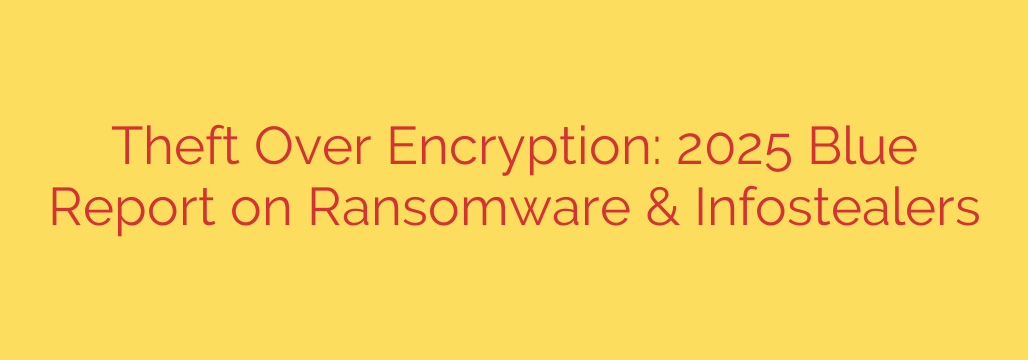
The New Ransomware Playbook: Why Cybercriminals Now Prefer Data Theft Over Encryption
For years, the word “ransomware” conjured images of locked files and frantic IT teams scrambling to restore from backups. The classic model was simple: attackers encrypt your data and demand a fee for the key. However, the landscape of digital extortion is undergoing a seismic shift. Today, savvy cybercriminals are realizing it’s often more profitable—and more terrifying for their victims—to steal data rather than just encrypt it.
Recent analysis of cybercrime trends reveals a clear and concerning pattern: attackers are increasingly prioritizing data exfiltration over simple encryption. This marks a fundamental change in strategy, moving from holding systems hostage to holding sensitive information hostage. For businesses, this new reality demands an immediate re-evaluation of cybersecurity priorities.
The Waning Power of Encryption-Only Attacks
The traditional ransomware model is facing diminishing returns for cybercriminals. Organizations have become more resilient, largely due to:
- Robust Backup and Recovery Systems: Companies that can quickly restore their data from clean backups have little incentive to pay a ransom.
- Improved Decryption Tools: Security researchers and law enforcement have successfully developed decryptors for various ransomware strains, rendering some attacks powerless.
- Law Enforcement Crackdowns: International efforts have disrupted major ransomware gangs, making their operations riskier.
While encryption attacks are far from extinct, their effectiveness as a standalone threat is declining. Criminals have adapted by embracing a more potent form of leverage.
The Meteoric Rise of Data Theft and Infostealers
The primary weapon in this new strategy is the infostealer, a type of malware specifically designed to covertly harvest and exfiltrate valuable information. Instead of locking down an entire network, these tools silently siphon off critical data, including:
- Customer lists and Personally Identifiable Information (PII)
- Financial records and banking credentials
- Intellectual property, trade secrets, and product designs
- Employee credentials and internal communications
Once this data is secured, the extortion begins. The threat is no longer just about business disruption; it’s about catastrophic reputational damage, regulatory fines, and the complete loss of competitive advantage. Cybercriminals now threaten to leak stolen data publicly or sell it on the dark web if their demands are not met. This tactic, often called “double extortion” when combined with encryption, is now frequently used on its own. The fear of a public data breach is often a far more powerful motivator to pay than the inconvenience of downtime.
Key Trends Shaping the Threat Landscape
This evolution from encryption to exfiltration is driven by a few key trends within the cybercrime ecosystem:
Focus on High-Value Data: Attackers are becoming more surgical. They actively hunt for the most sensitive data that will inflict the maximum pain if exposed, ensuring they have the strongest possible leverage during negotiations.
The Role of Initial Access Brokers (IABs): The cybercrime underground is highly specialized. IABs compromise networks using methods like phishing or exploiting vulnerabilities and then sell that access to ransomware or data theft groups. Infostealers are often the first tool used to establish this initial foothold.
Speed and Automation: Attacks are happening faster than ever. Automated tools can scan for vulnerabilities, deploy infostealers, and exfiltrate gigabytes of data before a security team even detects an anomaly.
Actionable Steps to Defend Against Data Exfiltration
Protecting against this new paradigm requires a security posture that prioritizes data protection over just system availability. Your goal must be to prevent unauthorized access and movement of data from the outset.
- Implement Strict Access Controls: Enforce the Principle of Least Privilege. Employees should only have access to the data and systems absolutely essential for their jobs. This minimizes the potential damage if an account is compromised.
- Deploy Multi-Factor Authentication (MFA): This remains one of the single most effective defenses against account takeover. Ensure MFA is enabled on all critical accounts, especially for remote access and cloud services.
- Enhance Endpoint Security: Use a modern Endpoint Detection and Response (EDR) solution. These tools are designed to identify the suspicious behaviors characteristic of infostealers and data exfiltration, such as unusual file access or large outbound data transfers.
- Classify and Monitor Your Data: You cannot protect what you do not know you have. Invest in tools and processes to discover, classify, and monitor your most sensitive data. Set up alerts for any unusual activity involving these critical information assets.
- Conduct Continuous Security Awareness Training: Your employees are your first line of defense. Regular training on recognizing phishing attempts and practicing good security hygiene can prevent the initial compromise that often leads to a major data breach.
- Develop a Comprehensive Incident Response Plan: Your plan must now explicitly account for a data theft scenario. Who do you contact? How do you assess what was stolen? What are your legal and regulatory notification obligations? Practice this plan regularly.
The shift from encryption to data theft is not a future prediction—it is the current reality. By understanding this new playbook and proactively strengthening your data-centric defenses, you can better protect your organization from the devastating consequences of modern digital extortion.
Source: https://www.bleepingcomputer.com/news/security/when-theft-replaces-encryption-blue-report-2025-on-ransomware-and-infostealers/








